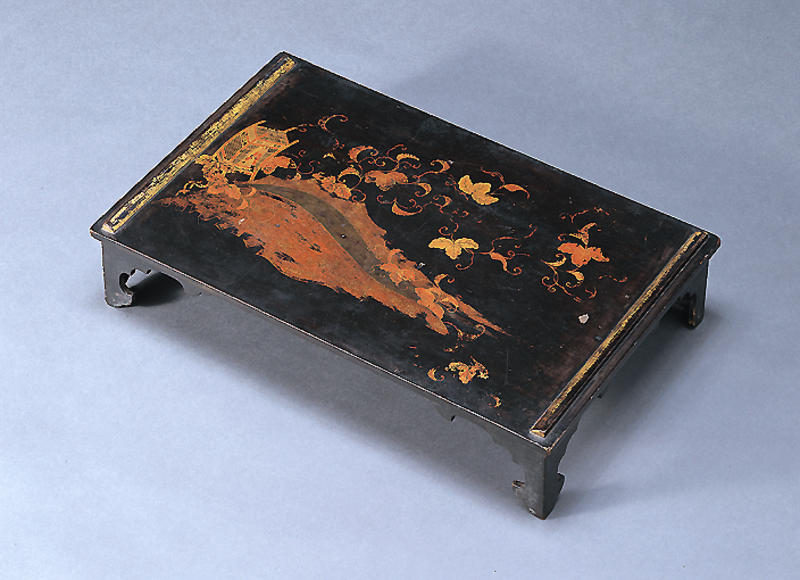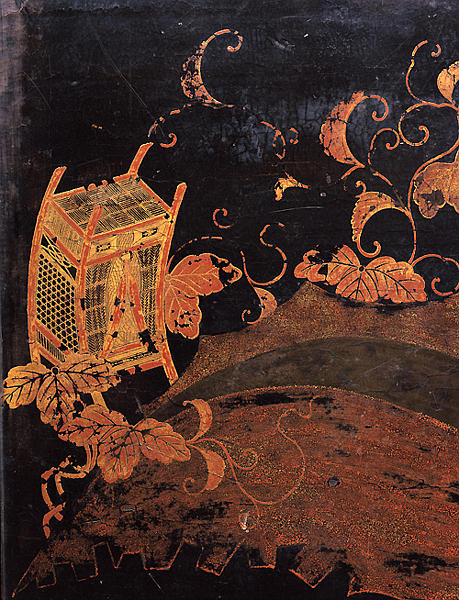蔦細道蒔絵文台
- 安土桃山〜江戸時代
- 16〜17世紀
- 木製漆塗蒔絵
- H-11.5 D-34 W-54.7
- 所蔵
- MIHO MUSEUM
桃山時代 16世紀
幅:54.7cm 奥行:34.4cm 高:11.5cm
総体黒漆塗の小振りの文台。文台は室町時代書院飾の文房具として硯箱と一具をなした。詩歌や連歌などの席で用いられる小形の机。長方形の天板の両端に筆返しをつけ,四隅に四脚を付属させる構造をもつ。
本品は天板に『伊勢物語』第九段の「宇津の山」を表現している。蔦の生い茂る細くて暗い宇津の山で東下りをする公家(業平)の一行が京に帰る修験者に会い,京の女性に文を托すという条を意匠している。
宮内庁三の丸尚蔵館にこの文台と同意匠・同時代製作になる文台・硯箱が所蔵されているが,この意匠は総体沃懸地,金高蒔絵,金銀金具,切金をふんだんに用いた豪華絢爛たるもので,全く趣を異にしている。
この文台は漆黒の天板面に極度にデザイン化した「蔦細道」を配している。抽象化された細道に唐草風に散らした蔦,その左端に修験者を意味する笈を描いたものである。
技法的には紅柄漆で図様を描き,そこに金粉を蒔いた平蒔絵。部分的には金粉が落剥して下絵の紅柄漆が露出している。しかし,当時大流行をみた高台寺蒔絵の手法で絵梨地(普通地蒔に用いる梨地を文様内に用いたもの),付描(一度蒔絵した面にもう一度細線を蒔絵するもの),描割(描きたい線を蒔絵せず逆に残して表現するもの)の細部の技法も用いられている。 (灰野)
Catalogue Entry
Momoyama period, 16th century
Height, 11.5cm; width, 54.7cm; depth, 34.4cm
A small writing desk coated entirely in black lacquer. The writing desk formed a set with an inkstone box as writing equipment displayed in the shoin writing alcove in the Muromachi period. They would also have been used as a small table during poetry recitations or renga writing gatherings. The rectangular form of the top board is fitted with brush stops at both sides, and four legs have been attached at each of the board's four corners.
This writing desk has a top board decorated with the Utsunoyama scene from the 9th chapter of the Tale of Ise. This chapter recounts the scene where a nobleman (Narihira) is heading away from Kyoto along a narrow, ivy-covered lane on the gloomy mountain hillside of Utsunoyama. Along this path, Narihira encounters a mountain ascetic heading towards Kyoto, and he entrusts a letter to a woman in the capital to this monk.
The Imperial Household Agency's Sannomaru Shozokan Museum owns a writing desk and inkstone box of the same period decorated with this same motif, but the Sannomaru works are decorated with an uninterrupted use of ikakeji ground, gold takamakie, gold and silver metal fittings, and cut gold leaf to create a magnificent effect completely differing in taste from the present desk.
The present writing desk has an extremely stylized rendition of the "ivy-covered path" theme arranged across the top of its central surface. An abstractly rendered path is scattered with ivy drawn in a karakusa-like vining pattern, while the portable shrine box placed on the far left of the image suggests the presence of the mountain ascetic.
Technically, this image was drawn in red lacquer, and then gold powder was sprinkled on this design to create a hiramakie effect. In some areas, this gold powder has fallen away, exposing the underlying red lacquer underdrawing. There is also, however, ample use of the then-popular forms of Kodaiji makie with an enashiji pictorial pearskin ground and tsuke-gaki (thin makie lines are drawn on top of a previously laid makie surface) and kaki-wari (drawn lines are not covered with makie, but rather are left blank) depictive detailing. AH

